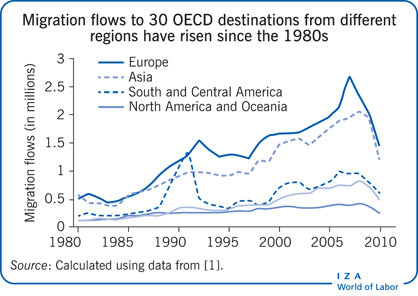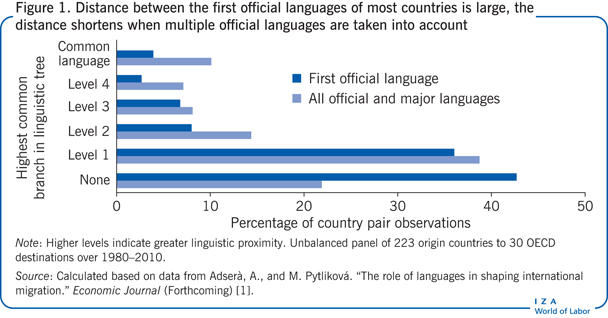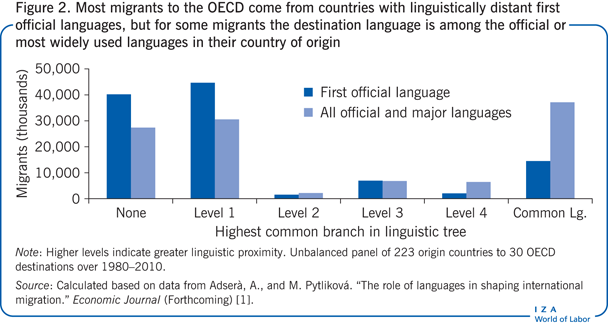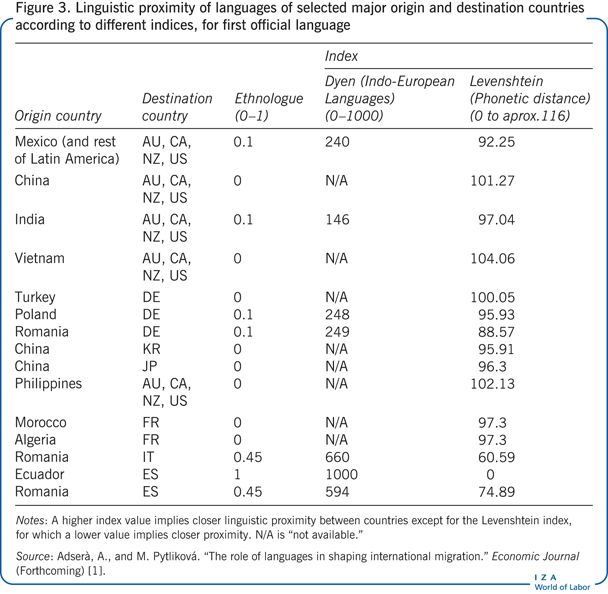Elevator pitch
As migration flows to developed countries have increased in recent decades, so have the number of countries from which migrants arrive. Thus, it is increasingly important to consider what role differences in culture and language play in migration decisions. Recent work shows that culture and language may explain migration patterns to developed countries even better than traditional economic variables, such as income per capita and unemployment rates in destination and origin countries. Differences in culture and language may create barriers that prevent the full realization of the potential economic gains from international mobility.

Key findings
Pros
Self-selection to more culturally similar destination countries boosts returns to human capital and improves integration.
Large communities of people with the same language and culture in destination countries encourage moves and decrease migration costs.
Acquiring skills in the language of the destination country is a human capital investment, even for temporary migrants.
Knowing the most widely spoken languages (in particular, English) provides an additional advantage to migrants.
Historical ties (especially when colonial languages are also an official language in the origin country) lower migration costs.
Cons
If migrants respond to linguistic and cultural barriers in some countries by migrating to countries with closer cultural ties to their country of origin, they may miss out on larger economic gains elsewhere.
Restrictive migration and naturalization policies that include a premium for knowledge of local languages increase selection.
Linguistic and cultural enclaves may reduce the return to skills.
Cultural enclaves may marginalize migrants by reducing socio-economic assimilation.
It is difficult to measure fluency in second languages and understand their role in migration decisions.
Author's main message
Differences in language and customs between countries imply costs that potential migrants likely consider in deciding whether to migrate and where to go. Fluency in the language of the destination country—and ease of learning it—can facilitate the transfer of migrants’ skills to the new labor market, contributing to the global interchange of skills and stimulating economic growth. Policies promoting instruction in foreign languages can foster the international mobility of workers, with potentially large individual and social returns through increased worker productivity and quicker socio-economic integration of new arrivals.
Motivation
After the mid-1980s, migration flows to developed countries started to increase and to become more diverse. Increases have been especially notable from Asian countries, followed by Latin American and African countries. Analyses of such immigration patterns have been made possible by new data sets on migration, such as the one employed in the Illustration with inflows and stocks of foreigners in 30 OECD destination countries from 223 origin countries over 1980–2010 [1], [2]. With the rising diversity of countries of migration origin, it is likely that linguistic and cultural barriers play an increasing role in explaining international migration flows, even after taking into account differences in economic conditions between origin and destination countries. If the linguistic and cultural differences are large, migrants may react by selecting destinations with closer ties with their own culture, even if potential economic gains are greater elsewhere, thus reducing the economic gains from migration.
Discussion of pros and cons
Linguistic distance and migration flows
To understand the direction and the size of migration flows, analysts have generally employed a human capital investment model [3], [4]. According to this model, a potential migrant analyzes the net utility derived from migrating to various locations to decide whether and where it is optimal to move. Calculations of the net welfare at each location factor in expected earnings, likelihood of employment, and direct and indirect migration costs. Costs can encompass a wide range of items, from such out-of-pocket costs of migrating as transportation and new housing to the psychological costs of leaving one’s country, family, and friends and the costs associated with a temporary depreciation in the value of one’s skills [1]. The larger the differences between a potential migrant’s culture and language and those of the destination location, the more difficult and expensive migration becomes by reducing the transferability of skills and the ability to understand local norms and expectations.
There are multiple channels through which the linguistic “distance” between a migrant’s own language and that of the destination country affects the migration experience. Better proficiency in the local language is associated with a greater return to current human capital in the destination country labor market, better job matches, and faster career progression [5], [6]. It also speeds skill upgrading and eases access to the credentials needed for some professional careers and businesses. Proficiency in the destination country language may make it easier to get a visa or qualify for permanent residency and, as a result, may facilitate migration itself. Language proficiency also helps new arrivals navigate local institutions and understand their rights to employment and government benefits. Finally, language proficiency may ease migrants’ social adaptation and integration.
Measuring the impact of linguistic distance
The role of linguistic barriers has generally been studied using gravity models to predict the degree of interaction between two places. Gravity models consider both pull and push factors between places, as well as distance. To them, researchers add indicators of language similarities between origin and destination countries and, in some instances, measures of the distance between them.
Initial findings on the role of language in determining migration flows were mixed, in part because of limited data on migration flows and stocks. Findings have been more nuanced in recent research, since larger and more heterogeneous panel data sets have become available and a broader set of measures developed to capture linguistic distance between countries.
The most basic way to introduce a measure of language as a barrier to migration is to use an indicator of whether two countries share a language. Some studies find that sharing a common language increases migration flows [3], [7], whereas other studies do not [4], [8]. A plausible explanation for this inconsistency is the smaller size and restricted sample in studies that do not find a positive relationship. These studies are generally limited to migration flows into a small set of developed countries [8]. In contrast, a study of flows into the US from a large sample of 81 countries during 1971–1998 finds higher migration inflows from countries in which English is the first official language. However, this effect is no longer significant once the presence of prior immigrants from the same country in the US is taken into account [9].
Most recent studies employ more sophisticated measures to capture the linguistic distance between two countries. One study uses the number of common nodes on the linguistic tree (a representation of a group of languages related through descent from a common linguistic ancestor) shared by the languages to measure the impact of cultural differences on the tendency of people with a higher level of education to migrate to countries with closer languages [10]. The study finds a net positive effect of language on skill selectivity, indicating that a closer relationship between languages facilitates the transferability of human capital. Individuals with more human capital thus self-select to migrate to destinations with languages that are closer to their native language.
Likewise, other studies have employed a linguistic proximity index based on the similarity of samples of words between Indo-European languages to illustrate that cultural differences explain patterns of migration flows between OECD countries better than economic opportunities [11]. The results imply that a one unit increase in the linguistic distance between two languages lowers migration flows between two countries by 56%, an effect twice as large as that of a similar increase in GDP per capita.
Recently, a study developed a linguistic proximity measure that varies depending on how many branches of the linguistic family tree languages have in common [1]. The study created three indicators: one that measures the distance between the first official language in the destination and the first official language in the source country; a second for the minimum distance between any pair of official or most widely spoken languages in each country, and a third for the most widely used language in each country (which in some cases is not the official language) [1]. Figure 1 shows the distribution of country pairs in the sample according to the highest level of the linguistic tree that the languages of the two countries share (either the first official language of the countries, since in some cases there is more than one, or the closest match between any of the official and most-widely spoken languages for the two countries). Linguistic proximity improves in some cases when any official or widely spoken language is considered rather than only the first official language, as many former colonies adopted the language of their colonizers as one of multiple official languages.
Compared with some traditional economic push and pull factors discussed in the migration literature, this study finds that the impact of linguistic proximity on migration flows is lower than that of ethnic networks or income per capita in the destination country, but much stronger than that of unemployment rates [1]. Emigration flows to countries with the same language as in the origin are 20% higher than to countries with a language that does not share any level on the linguistic tree. For example, emigration rates to France are predicted to be around 18% higher from Benin, where French is the first official language, than from Zambia, whose first official language shares only one level of the linguistic tree with French, and 6% higher than from São Tomé, whose language shares four levels of the linguistic tree family.
However, using a more comprehensive data set than analyses that are restricted to migration between OECD countries, recent research finds a much smaller implied role for linguistic distance [1], [11]. A one standard deviation increase in linguistic proximity raises migration flows by just 0.02 standard deviations (a tenth of the impact of a similar change in GDP per capita but a larger impact than that of higher unemployment). The result also holds when either the linguistic proximity between the most commonly used language in each country or the minimum distance between any of multiple official and most widely spoken languages in each country is used. Figure 2 presents the size of immigration flows for different levels of linguistic proximity. The majority of migrant flows occur between linguistically distant countries when the distance is measured only between the first official language in origin and destination countries. Not surprisingly, flows are somewhat larger at high levels of linguistic proximity when a comprehensive measure is used that includes multiple official and widely spoken languages rather than just the first, since the language of the former colonial power is often one of many official languages in former colonies.
Finding an increase in migration to countries with the closest linguistic proximity to the language in the origin country holds also for other measures of linguistic distance, such as the Dyen index for Indo-European languages and the Levenshtein distance measure, which are based on the phonetic dissimilarity of a core set of the 40 more common words across languages (see Figure 3). Migration flows to countries with the closest linguistic proximity are around 14–20% larger than to countries with the most distant languages [1]. Overall, linguistic proximity’s relevance in explaining the direction of migration flows increases with the share of more highly educated workers in the origin country, likely because of the greater need for skill transferability in the destination labor market among highly skilled migrants.
The special position of English
A few languages are widely used in international transactions, in the media, and in the job market, regardless of location. Among them, English is clearly the most popular. Having a widely spoken language as the local language in the destination country can constitute an immigration pull factor on its own. First, since schools in many countries teach English as a second language, immigrants are more likely to have some basic knowledge of English and may prefer to move to English-speaking destinations to lower the costs associated with transferring their skills. Exposure to English can also come through the media, including movies [1]. Second, as an extensive literature has already shown, English proficiency may be an asset in the labor market of the country of origin, and the opportunity to improve English proficiency by migrating to an English-speaking country may be a pull factor for migrants who hope to use these skills when they return home [12].
A study that uses a large panel data set to estimate the impact of linguistic proximity for English- and non-English-speaking destinations finds that linguistic proximity matters more for non-English-speaking destinations [1]. Pre-migration exposure to English by the average migrant probably weakens the relevance of linguistic proximity indicators for English-speaking destinations. Thus, English seems to constitute less of a barrier to migrants than other languages.
Additional cultural and religious barriers
Other cultural differences between countries may also influence a migrant’s destination choice. Again, the wider the gap between origin and destination countries in other dimensions, the higher the expected costs of adaptation to the new location.
One traditional way of measuring cultural distance is to use an indicator of whether two countries share a common colonial history. Most of the recent studies reviewed here (with the exception of [8]) find a positive and significant association for immigration flows between two countries linked by colonial history, implying larger immigration flows [1], [2], [3], [4]. For countries in the most comprehensive panel data set of international migration flows, having a past colonial tie with a particular destination country increases emigration by around 16% [1]. Past colonial ties might reduce the cultural distance between countries and increase the information available about a potential destination country. Further, a former colony may have adopted the language of the colonizer country as an official language, and some educational activities may be conducted in this language.
To understand the role of cultural barriers in migration between OECD countries, a recent study employs a set of innovative variables to account for additional forms of cultural distance. Religious proximity between countries is measured by looking at the probability of randomly drawing two individuals, one in each country, of different religious groups. Migration flows between countries decrease by 35% as the religious distance between the countries increases by one standard deviation [11].
This study also computes two innovative indices to account for differences in norms and values between two societies [11]. One measure is based on the views individuals hold on a set of values, including acceptance of power, individualism, and gender roles. The second measure is based on a comprehensive set of questions from the World Values Survey on issues such as family, divorce, homosexuality, political life, and gender roles in the labor market. Overall, the results show that cultural barriers (including language) are better in accounting for the direction and size of migration flows across OECD countries than difference in economic conditions [11]. The smaller gaps in income per capita (or other economic indicators) within the OECD than within a panel of countries from more heterogeneous regions may explain the larger relevance of cultural gaps for developed countries.
Genetic differences (measured by the differences in the distribution of alleles in both populations) have also been used to approximate differences in norms and behavior in studies of cross-country differences in development. When measures of the genetic distance between populations of destination and origin countries are added as indicators of cultural factors, genetic distance is found to reduce migration flows only if the number of people from the same country who already reside in the destination country (potential networks) is not taken into account. Once such network controls are added, genetic distance becomes irrelevant [1]. However, linguistic distance remains significant in explaining migration flows even when genetic distance is taken into account, suggesting language has an independent impact on migration costs beyond any migration-facilitating effects of moving to a country where people may look more like (or be culturally more similar to) the migrant [1].
Ethnic and linguistic enclaves
Having a large community of people in the destination country with similar cultural and linguistic backgrounds as a potential migrant may reduce the relevance of any linguistic gap. In some countries, these communities tend to cluster in particular areas or neighborhoods (such as “Chinatown,” “Little Italy,” and “Germantown”). Migration flows are clearly larger to destinations with large numbers of ethnic and linguistic enclaves whose members might offer new arrivals practical information and psychological support [1], [2], [8], [11], [13]. Thus, linguistic proximity between a migrant’s native language and the language of the destination country matters significantly less in such cases [1]. In these destination countries, there is likely to be less pressure to learn the national language immediately after arrival since new migrants can work within a relatively closed community. These linguistic or cultural enclaves can constitute a mixed blessing for migrants, however, if they slow their (and their children’s) socio-economic adaptation to their new country of residence.
The role of immigration and naturalization policies
Because of its role in easing integration into the destination country, language plays a prominent role in immigration policy, which likely affects the selection of immigrants across destinations. Immigration policies in countries such as Australia, Canada, and New Zealand, but not the US, emphasize the skills of potential migrants. When issuing permanent resident visas, points are given to candidates based on such characteristics as English language proficiency (plus French in Canada), educational attainment, and age at migration.
One study investigates how changes in the strictness of entry requirements affected the size and direction of migration flows to 14 developed countries during 1980–1995 [8]. Stricter policies that require applicants to have higher skills and some knowledge of the national language (such as in Australia or Canada) may result in a more positively selected pool of migrants and decrease the relevance of traditional pull and push factors (such as differences in income per capita) in explaining migration flows. The study finds that stricter immigration rules reduce the relevance of push factors more than pull factors (such as linguistic closeness), and as a result, cultural and linguistic differences may become more relevant after such a policy change [8].
Another study finds that shifting to a point-based immigration system raises the share of high-skilled workers in the pool of migrants by about six percentage points [10]. As a result, introducing a skill-based immigration policy is likely to increase the degree of proficiency in the national language among new arrivals (compared with the absence of such a policy) and to shift the composition of new immigrants toward origin countries whose languages are the same or relatively close to that of the destination country.
Finally, a recent study shows that, while cultural distance (as measured by values and norms) is not relevant in explaining migration between OECD countries with open borders, language and religion still explain some of the differences in flows across those countries [11].
Naturalization policies may also affect the cost of migration. In many countries, naturalization involves some type of language proficiency test. In choosing among destinations, migrants may consider not only their ability to move permanently to a new location, but also how easily they can acquire full citizenship rights, particularly in countries where some labor market access or welfare programs are restricted to nationals. When a measure of the existence and restrictiveness of language requirements for naturalization is included in a study of 30 OECD destinations over 1980–2010, migration flows are found to be smaller to countries with stricter language requirements [1]. This result is consistent with a general expectation that stricter requirements deter migration. However, linguistic proximity between origin and destination continues to independently matter as a determinant of migration.
Limitations and gaps
Analysis of the cultural determinants of migration flows has taken off recently thanks to new, larger data sets on migration flows and stocks. Until recently, most studies were confined to migration between OECD countries and to a limited timespan. New data sets that encompass a large panel of origin and destination countries or contain information on the educational attainment of migrants from many origin countries provide a more heterogeneous set of country pairs to test the relevance of culture for migration decisions [1], [7]. Still, most analyses rely on aggregate migration flow and stock data, which do not permit easy measurement of potential migrants’ average knowledge of destination country languages. This makes it difficult to completely control for selection by origin country. Further, there is no easy way to distinguish individual groups from each other in terms of cultural distance. For example, it might be that migrants from some origin countries are mostly people of certain racial or ethnic minority groups (perhaps with a language different from the country’s main language) or people abandoning their cultural backgrounds in search of something new.
A growing literature on the educational, labor market, and other social outcomes of migrants, is beginning to employ measures of cultural-linguistic distance at the micro level. This new strand of research should provide a better understanding of the actual costs of large cultural barriers facing potential migrants.
Finding appropriate measures of cultural differences and interpreting them is also challenging. All research on linguistic distance reviewed here assumes some form of symmetry in the ability to move from one language to another, whereas in reality it might be easier, for example, for a Portuguese speaker to learn Spanish than for a Greek speaker. Similarly, other indices of cultural distance may not properly capture the full adaptation costs.
Finally, the current research is likely to underestimate some of the gains and spillovers from close cultural ties and language knowledge related to consumption, social and civic activities, and other human capital investment activities.
Summary and policy advice
Research on the cultural and linguistic barriers to migration helps to understand the determinants of the direction of migration flows across countries and highlights the importance of moving costs as obstacles to greater international flows. The findings reviewed here imply that linguistic and cultural borders are significant and that they may impede full realization of the economic gains from migration by keeping immigration rates low despite high earnings and employment differentials between origin and destination countries.
Considering the large role that linguistic and cultural factors seem to play in migration decisions, efforts to facilitate labor mobility should include strategies for reducing cultural distances between countries. Policies to encourage foreign language instruction are an obvious choice [11]. Israel, for example, offers new migrants subsidies and access to training programs to encourage learning Hebrew. Such policies can have large returns at both the individual and the societal level by increasing the productivity of workers and facilitating other forms of socio-economic integration of new arrivals. Policies promoting instruction in foreign languages in both immigrant-sending and -receiving countries can foster the recruitment and mobility of international workers, which recent studies link to an increase in cultural exchanges and firms’ competitive advantage. International workers with better knowledge of the language of the destination country or of a widely spoken language facilitate the global interchange of skills and stimulate economic performance.
Further, better language skills are also linked to better social outcomes for first- and second-generation migrants. Educational attainment and ultimate labor market outcomes of the second generation hinge, in part, on their parents’ ability to understand the local institutions and navigate the system.
Acknowledgments
The author thanks an anonymous referee and the IZA World of Labor editors for many helpful suggestions on earlier drafts. Previous work of the author contains a larger number of background references for the material presented here and has been used intensively in all major parts of this article [1].
Competing interests
The IZA World of Labor project is committed to the IZA Guiding Principles of Research Integrity. The author declares to have observed these principles.
© Alícia Adserà


